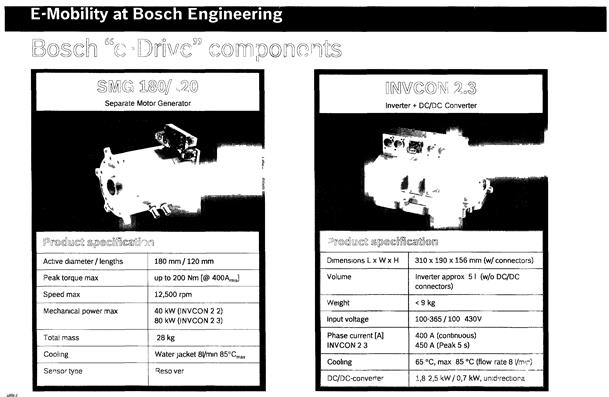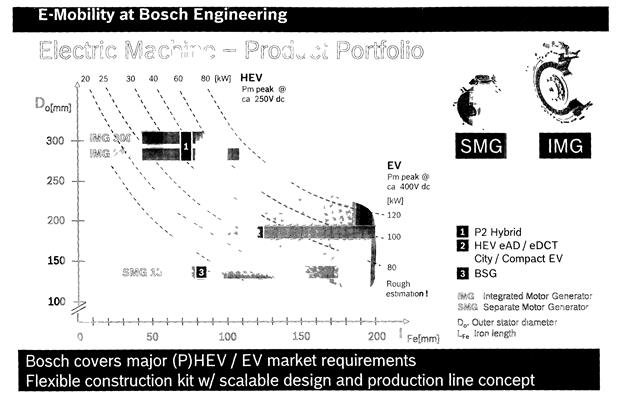Тяговые электрические двигатели (ТЭД). История применения ТЭД в ЭМ начиналась с применения электродвигателей постоянного тока последовательного возбуждения
История применения ТЭД в ЭМ начиналась с применения электродвигателей постоянного тока последовательного возбуждения, как наиболее подходящие по простоте конструкции и очень подходящей электромеханической характеристике (мягкая характеристика). Затем был период перехода с ТЭД с независимой обмоткой возбуждения, что позволило значительно упростить применяемую коммутационную аппаратуру (малые токи нагрузки).
Решение упрощения и уменьшение цены аппаратуры управления, отсутствие щеточно-коллекторного узла и др. привело к широкому применению асинхронных машин переменного тока.
Достижением в конструкции асинхронных электродвигателей является применение постоянных магнитов.
И самое последнее в нынешний период является применение синхронных машин с постоянными магнитами.
На рисунке 4.6 приведены разрабортанные фирмой «Bosch» разделенный мотор-генератор (SMG) и интерированная синхронная электрическая машина (INVCON), которые сейчас получили наибольшее развитие и применяются на автотранспортных средствах с электроприводом.
Интересно предложение фирмы «Bosch» по типоразмерному ряду ТЭД (зависимость диаметра от длины ротора электрических машин), которые можно использовать на автотранспортных средствах с электроприводом (рис. 4.7).
Различные схемные решения по применению ТЭД в ЭМ показаны на рисунке 4.8.

Рис. 4.6. Разрабортанные фирмой «Bosch» разделенный мотор-генератор
(SMG) и интерированная синхронная электрическая машина (INVCON)

Рис. 4.7. Предложение фирмы «Bosch» по типоразмерному ряду ТЭД (зависимость диаметра от длины ротора электрических машин), которые можно использовать на автотранспортных средствах с электроприводом

Рис. 4.8. Различные схемные решения по применению ТЭД в ЭМ
Список литературы к главе 4
1. Эйдинов А.А., Яковлев А.И. Возможные пути развития энергетичес-ких установок автомобилей//Автомобили и агрегаты: Сб. науч. тр. НАМИ.
-1999, -Вып. 223, -С. 48-69.
2. Ледоренко Н.С. и др. Электромобиль ВНИИТцентр, 1984 г.
3. N. Furukawa et all, "EV 24h Travel Distance Record Challenge," the 17th International Electric Vehicle Symposium (EVS-17), Montreal, Canada, 2000
4. Ph. Blanchard, D. Cesbron, G. Rigobert and G. Sarre, "PERFORMANCE OF SAFT LI-ION BATTERIES FOR ELECTRIC VEHICLES", the 17th International Electric Vehicle Symposium (EVS-17), Montreal, Canada, 2000.
5. Патент РФ RU 2156533 Cl УСТРОЙСТВО НИВЕЛИРОВАНИЯ РАЗБАЛАНСА НАПРЯЖЕНИЙ НА СОЕДИНЕННЫХ МЕЖДУ СОБОЙ ЯЧЕЙКАХ АККУМУЛЯТОРНОЙ БАТАРЕИ ИЛИ БАТАРЕЯХ. Заявитель: Никифоров В.Е. Дата публикации 20.09.2000.
6. Патент РФ RU 2360334 С1. БАТАРЕЯ ХИМИЧЕСКИХ ИСТОЧНИКОВ ТОКА С БАЛАНСОМ НАПРЯЖЕНИЙ. Заявитель: "АФМ Сервере" Общество с ограниченной ответственностью (RU). Дата публикации: 27.06.2009.
7. Патент РФ RU 2364992 С2. СПОСОБ СБАЛАНСИРОВАННОЙ ЗАРЯДКИ ЛИТИЙ-ИОННОЙ ИЛИ ЛИТИЙ-ПОЛИМЕРНОЙ БАТАРЕИ. Заявитель: ПЕЛЛЕНК (FR). Дата публикации: 20.08.2009.
8. Moore S. W., Schneider P. J. A Review of Cell Equalization Methods for Lithium Ion and Lithium Polymer Battery Systems. Society of Automotive Engineers. 2001.
9. Martinez C, Sorlien D., Goodrich R., Chandler L., Magnuson D. Using Cell Balancing to Maximize the Capacity of Multi-cell Li-Ion Battery Packs. AN167. www.xicor.com.
10. СИХУА УЭН (SIHUA WEN). Выравнивание заряда батарей обеспечивает долгое время работы и продлевает срок службы Copyright 2009 Texas Instruments.
11. F.-J. Paefgen, M. Lehna, ATZ Automobiltechmsche Zeitschrift, 99(6) (1997).
12. H. Toshihiro, in: A. Krappel (Ed.) and 30 co-authors, Kurbelwellenstartergenerator (KSG) – Basis für zukünftige Fahrzeugkonzepte, 2nd Edition, Expert-Verlag, Renningen-Malmsheim, Germany, 2000 pp. 107-119.
13. R. Erikson, in: A. Krappel (Ed.) and 30 co-authors, Kurbelwellen-Startergenerator (KSG) – Basis für zukünftige Fahrzeugkonzepte, 2nd Edition., Expert-Verlag, Renningen-Malmsheim. Germany 2000 pp. 120-133.
14. T. Teratani, K. Kuramochi, S. Nakamura, in: A. Graf (Ed.), The New Automotive 42-V PowerNet – Preparing for Mass Production, Expert-Verlag, Renningen-Malmsheim, Germany, 2001 pp. 29-47.
15. J.G. Kassakian, H.C. Wolf, J.M. Miller, J.J. Hurton, Proc. IFEE Workshop on Power Electronics for Transportation, Dearborn, MI, USA, October 24-25, 1996, p. 3: and IEEE Spectrum, August 1996 p. 22.
16. J. Kassakian, VDI Berichte, 1287 (1996) 35-47.
17. J. Kassakian, VDI Berichte, 1415 (1998) 21-53.
18. A. Graf (Ed.), Proceedings of the 1st International Congress 42-V PowerNet: the First Solutions, 28-29 September 1999, Villach, Austria.
19. H.-D. Hartmann, in: A. Graf (Ed.), Proceedings of the 1st International Congress 42-V PowerNet: the first solutions, 28-29 September 1999, Villach, Austria.
20. A. Graf (Ed.), The New Automotive 42-V PowerNet – Preparing for Mass Production, Expert-Verlag, Renningen-Malmsheim, Germany, 2001; Proceedings of the 2nd International Congress on 42-V PowerNet, 24-25 April 2001, Ludwigsburg, Germany.
21. W. Buschhaus, L.R. Brandenburg, R.M. Stumtz, Proceedings of 15th Electric Vehicle Symposium EVS-15, 1-3 October 1998, Brussels, Belgium, pp. 3-4.
22. W. Buschhaus, A.K. Jaura, M.A. Tamor, VDI Berichte 1459 (1999) 123.
23. S. Sasaki, Proceedings of 14th Electric Vehicle Symposium EVS-14, 15-17 December 1997, Orlando, FL, USA 1997.
24. G. Killmann, T. Yeagashi, K. Hirose, T. Takaoka, VDI Berichte, 1459 (1999) 109-121.
25. D.V. Ragone. Review of battery systems for electrically powered vehicles. Mid-Year Meeting of the SAE, Detroit, May, 1968.
26. T. Christen, M.W. Carlen. Theory of Ragone plot. // Journal of Power Sources, (2000) 91 210-216.
27. K. Takahashi, H. Yasuda, H. Hasegawa, S. Horie, K. Kanetsuki. // Journal of Power Sources, 53 (1995) 137-141.
28. S. Fouache, J.P. Douady, G. Fossati, C. Pascon. // Journal of Power Sources, 67 (1997) 15-26.
29. J.R. Pierson, J.P. Zagrodnik, R.T. Johnson. // Journal of Power Sources, 67 (1997) 7-14.
30. J. Höcker, G. Richter, VDI Berichte, 1418 (1998) 223-239.
31. E. Karden, S. Ploumen, B. Fricke, T. Miller, K. Snyder. Energy storage devices for future hybrid electric vehicles. // Journal of Power Sources 168 (2007) 2–1.
32. P.T. Moseley, D.A. Rand. Changes in the demands on automotive batteries require changes in battery design. // Journal of Power Sources 133 (2004) 104-109.
33. P.T. Moseley, B. Bonnet, A. Cooper, M.J. Kellaway. Lead-acid battery chaemistry adapted for hybrid electric vehicle duty. // Journal of Power Sources 174 (2007) 49-5.
34. L.T. Lam. // Journal of Power Sources, 133 (2004) 126-134.
35. E. Meissner, G. Richter, in: D. Rand, P.T. Moseley, J. Garche amd, C.D. Parker (Eds.), Valve-regulated Lead–acid Batteries, Elsevier Amsterdam, London, New York, 2004.
36. A. Cooper, L.T. Lam, P.T. Moseley, D.A.J. Rand, in: D. Rand, P.T. Moseley, J. Garche amd, C.D. Parker (Eds.), Valve-regulated Lead–acid Batteries, Elsevier, Amsterdam, London, New York, 2004.
37. M.L. Soria, F. Trinidad, J.M. Lacadena, A. S´anchez, J. Valenciano, Advanced valve-regulated lead–acid batteries for hybrid vehicle applications 10ELBC, 2006.
38. J. Valenciano, M. Fernбndez, F. Trinidad, L. Sanz. Lead-acid batteries for micro- and mild hybrid application. 11 ELBC Conference Warsaw, Poland, 23-26 September, 2008.
39. ALABC project ‘ISOTEST’ Final Report, 2007.
40. M. Saakes , R. Woortmeijer, D. Schmal. Bipolar lead–acid battery for hybrid vehicles. // Journal of Power Sources 144 (2005) 536–545.
41. http://www.effpower.com
42. A. Cooper, J. Furakawa, L. Lam, M. Kellaway. The Ultra-Battery – a new battery design for a new beginning in hybrid electric vehicle energy storage. 11 European Lead Battery Conference, Warsow, 2008.
43. J. Furukawa, T. Takada, D. Monma, L.T. Lamb. Further demonstration of the VRLA-type UltraBattery under medium-HEV duty and development of the flooded-type UltraBattery for micro-HEV applications. // Journal of Power Sources 195 (2010) 1241–1245.
44. A. Jossen. Overview of present and future battery development. 2nd International Congress Advanced Battery Technologies. Frankfurt. 2009.
45.A. Burke. Cost-effective combinations of ultracapacitors and batteries for vehicle applications. Advanced Automotive Battery Conf. 2002 Las Vegas, USA.
46. Ultracapacitor Technology: State-of-Technology and Application to Active Parallel Energy Storage Systems, J.M. Miller, U. Deshpande, Maxwell Technologies, Inc, San Diego, СА, материалы 17го Международного семинара по конденсаторам с ДЭС и гибридным устройством накопления энергии; Дирфилд-Бич Фл., США, дек. 10-12, 2007 г.
47. M. Mastragostino, F. Soavi. Strategies for high-performance supercapacitors for HEV. // Journal of Power Sources 174 (2007) 89–93.
48. Химические источники тока. Справочник под ред. Н.В. Коровина, А.М. Скундина. М.: Изд-во МЭИ. 2003. 740с.
49. F.V. Conte, F. Pirker. Voltage depression growth assessment on Ni-MH batteries for HEV applications. EVS 21 March 2005.
50. D. Linden, T.B. Reddy. Handbook of batteries. 2002. 3rd ed. McGraw-Hill.
51. M. Yao, K. Okunob, T. Iwaki, S Tanase, K. Harada, M. Kato, K. Emurab, T. Sakai. High-power nickel/metal-hydride battery using new micronetwork substrate: Discharge rate capability and cycle-life performance. // Journal of Power Sources 171 (2007) 1033–1039.
52. J.C. Viera, M. Gonza´lez, B.Y. Liawb, F.J. Ferrero, J.C. A´ lvarez, J.C. Campoa, C. Blanco. Characterization of 109 Ah Ni–MH batteries charging with hydrogen sensing termination. // Journal of Power Sources 171 (2007) 1040–1045.
53. D. Ohms, M. Kohlhase, G. Benczur-Urmossy, K. Wiesener, J. Harmel. High performance nickel-metal hydride battery in bipolar stack design. // Journal of Power Sources 105 (2002) 120-126.
54. http://www.toyota.com
55. T. Fronzek. Hybrid Powertrains Battery Development & Plug-In. Advanced Battery Technology. Frankfurt. June 2009.
56. http://automobiles.honda.com
57. S. Bauer. Auto manufacturing. Electric cars: Plugged-in batteries must be included. 2nd International Congress on Advanced Automotive Batteries, Frankfurt, June 2009, Germany.
58. D. Howel. FY 2007 Progress report for energy storage research and development. Energy Efficiency and Renewable Energy Vehicle Technologies. 2008. US DOE 20585-0121. (http://www.eere.energy.gov).
59. L. Gaines, R. Cuenca. Cost of lithium-ion batteries for vehicles. 2000. Center for transportation research, Energy system division, Argonne National Laboratory.
60. R. Lache, P. Nolan, D. Galves, G. Toulemonde, G. Gehrke et al. Electric cars: Plug-in batteries must be included. 2008. Global Autos Research Team, Deutsche Bank.
61. A.K. Shukla, T.P. Kumar. Materials for next generation lithium-ion batteries. // Curr. Sci., 94 (3) 2008 314-331.
62. M.S. Whittingham. Materials Challengesfacingelectrical energy storage. // MRS Bulletin 33 (4) 2008 411-419.
63. H. Takeshita. Worldwide Market Update on NiMH, Li Ion and Polymer Batteries for Portable Applications and HEVs. President Institute of Information Technology, Ltd. 2008.
64. I.A. Profatilova, Nam-Soon Choi, Kyoung Han Yew and Wan-Uk Choi. The effect of ethylene carbonate on the cycling performance of a Si electrode. // Solid State Ionics 179 (40) 2008 2399-2405.
65. Nam-Soon Choi, Kyoung Han Yew, Wan-Uk Choi and Sung-Soo Kim. Enhanced electrochemical properties of a Si-based anode using an electrochemically active polyamide imide binder. // Journal of Power Sources 177 (2) 590-594.
66. P. Arora, Z. Zhang. Battery separators. // Chem. Rev., 104 (2004) 419-4462.
67. www.batteryuniversity.com
68. D.L. Anderson. An evaluation of current and future costs for lithium-ion batteries for use in electrified vehicle powertrains. Ph. D. thesis. Duke University. 2009.
69. Nano-enabled batteries for portable and rechargeable applications – types, applications, new developments. Innovative research and products (iRAP), Inc. 2009. 165pp.
70. Y. Wang, G. Cao. Developments in nanostructured cathode materials for high-performance lithium-ion batteries. // Advanced Materials. 2008. 20 2251-2269.
71. B. Lawson. The meaning of life. // Batteries and Energy storage technology. 25 (2009) 32-41.
72. P.G. Balakrishnan, R. Ramesh, T.P. Kumar. Safety mechanisms in lithium-ion batteries. // Journal of Power Sources. 155 (2006) 401-414.
73. Irina A. Profatilova, Nam-Soon Choi, Sae Weon Roh, Sung Soo Kim. Electrochemical and thermal properties of graphite electrodes with imidazolium- and piperidinium-based ionic liquids. // Journal of Power Sources. 2009. Vol. 192. P. 636-643.
74. Irina A. Profatilova, Sung-Soo Kim, Nam-Soon Choi. Enhanced thermal properties of the solid electrolyte interphase formed on graphite in an electrolyte with fluoroethylene carbonate. // Electrochimica Acta. 2009. Vol. 54 P. 4445-4450.
75. O. Bose. Ageing behavior of ultra high-power lithium-ion batteries for hybrid electric vehicles. 2nd International Congress on Advanced battery technologies. Frankfurt. June 2009, Germany.
76. D. Neumister. Thermal management of lithium-ion batteries in automotive applications. // 2nd International Congress on Advanced Battery Technology. Frankfurt. June. 2009.Germany.
77. C. Pilot. Present and future market situation for batteries. // 2nd International Congress on Advanced Battery Technology. Frankfurt. June. 2009.Germany.
78. EV, PHEV & HEV worldwide market 2008-2020 – Battery is a key. Avicenne. 2009. 179p.
79. Барзунев С.Н., Гуськов А.В. и др. «Накопители электрической энергии для АТС с КЭУ и ЭМ, Труды НАМИ, 2013.
ГЛАВА 5. РАЗВИТИЕ ТОПЛИВНЫХ ЭЛЕМЕНТОВ (ТЭ)
Дата добавления: 2014-12-24; просмотров: 1127;
